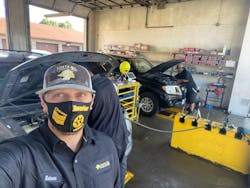If I lean a bit to my right, I can see a quick lube facility—it’s roughly three blocks north of our NOLN headquarters here in St. Paul, Minn. My view is a little fuzzy through the angle of the window (or maybe it’s my eyes?), but I can see the signage and I can see a line of cars waiting for service.
It’s busy. It’s always busy, especially on a nice spring day like the day I’m writing this (well, at least, it’s Minnesota-level nice for what we consider spring).
And it’s easy to see why: The operation is efficient, the line moves relatively fast, and while there are no frills or “extras” as part of vehicle service, everything with the actual work seems to go smoothly enough.
I’ve used this shop several times over the years, often for my vehicle’s oil changes (mostly in a panic when I glance at the windshield sticker and realize I’m two months and 2,000 miles overdue). But I couldn’t tell you one single, unique thing about it. In fact, I had to just look out the window again to double-check the name of it. I don’t recall any exceptional aspects, but I also don’t recall any issues whatsoever.
In my mind, the facility is perfectly and unequivocally … OK.
Associate editor Matt Hudson wrote a piece on some of the misconceptions that folks have about different aspects of the quick lube and fast maintenance industry; most are built off long-standing stereotypes the industry has worked to fight over the years. It’s a must read, and Matt works with various industry leaders to present simple, tangible solutions to correcting these misconceptions and pushing your operation to the next level.
In reading the piece, though, it made me think of that shop down the street—and just the overall perception of similar facilities all across my market here in the Twin Cities. You don’t need me to tell you about how some would describe our industry, and you certainly don’t need me to explain why they’re wrong. (And they most certainly are wrong.) But the challenge in fighting this type of consumer perception rests far more in the indifferent attitudes and mindsets that many consumers are left with following a typical, meets-expectations experience like the ones I said I’ve had at this nearby shop.
The challenge with changing someone’s mindset is that it often must happen in two steps: You first have to prove to them that they are incorrect about their perceptions, and then you have to prove it over and over again through consistency. It can’t be passive; it must be overt.
Your business is important to you. Your operation is unique. There are so many things you do exceptionally well, and you need to ensure that customers see it the way you do. You have to show them. And, if it’s a focus, day in and day out, when they glance down the street at your facility, hopefully they see what you want them to see.
Photo courtesy of Costa Kapothanasis
